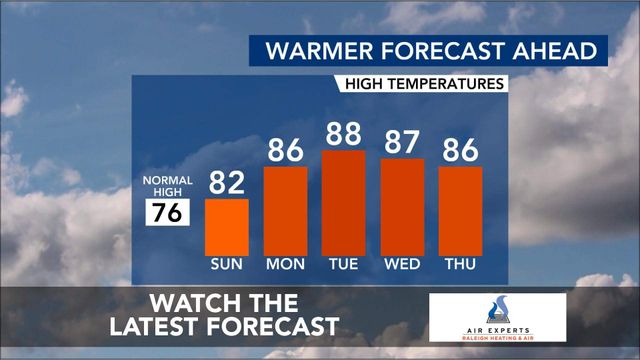All seasons, including fall, getting hotter across the Triangle
Fall is here, but summer heat is lingering, with highs in the 80s this week in Raleigh.
Temperatures have been rising across all seasons over the past five decades in Raleigh and Durham, according to data from National Oceanic and Atmospheric Administration Regional Climate Centers.
Winter has seen the biggest jump in average temperature.
Although Fall has seen the lowest change comparatively, it’s more than 2.5 degrees hotter than it was in 1970.

Lauren Casey, a meteorologist with Climate Central who analyzed recent data, says incremental shifts in temperature can make a profound difference.
"It's lengthening our allergy season, the season for disease-carrying pests, and the wildfire season which can increase the number of days with air pollution," Casey said. "It can also dull fall colors."
Extended periods of heat raises cooling demand, increasing electricity costs for consumers. North Carolina ranks among the top five states for the highest residential electricity use, according to the U.S. Energy Information Administration.
"Nationally and globally, we're seeing this trend for warming across seasons and that's because we're putting carbon into the atmosphere by the burning of fossil fuels, which enhances the greenhouse effect," Casey said.

September was wetter and warmer than normal in Raleigh.
The average temperature of 73.9°F was 1.3° above normal and the 5.48 inches of precipitation was 106% of the normal amount. Normal is defined relative to the 1991-2020 climate normal defined by The National Centers for Environmental Information, a U.S. government agency that manages one of the world’s largest archives of atmospheric data.
"Exposure to heat-related illnesses is now persisting into Fall, too," said Casey.
Data from the NC Department of Health and Human Services shows a spike in heat-related emergency room visits in September.
More than 71% of the nearly 4,000 visits across the state this year were among males and about a third were people between 25 and 44 years old.

"As we continue to warm our global temperature closer to that 1.5 degrees Celsius threshold, we're seeing more and more impacts," Casey said. "So, we need to do everything we can to curb our emissions and implement mitigation and adaptation strategies, because every 10th of a degree matters."









